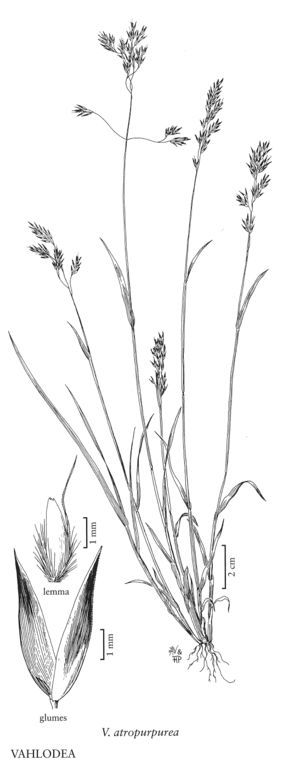Difference between revisions of "Vahlodea atropurpurea"
FNA>Volume Importer |
imported>Volume Importer |
||
| (5 intermediate revisions by 2 users not shown) | |||
| Line 7: | Line 7: | ||
|synonyms={{Treatment/ID/Synonym | |synonyms={{Treatment/ID/Synonym | ||
|name=Deschampsia atropurpurea var. latifolia | |name=Deschampsia atropurpurea var. latifolia | ||
| − | |authority= | + | |authority= |
| + | |rank=variety | ||
}} {{Treatment/ID/Synonym | }} {{Treatment/ID/Synonym | ||
|name=Deschampsia atropurpurea | |name=Deschampsia atropurpurea | ||
| − | |authority= | + | |authority= |
| + | |rank=species | ||
}} {{Treatment/ID/Synonym | }} {{Treatment/ID/Synonym | ||
|name=Vahlodea flexuosa | |name=Vahlodea flexuosa | ||
| − | |authority= | + | |authority= |
| + | |rank=species | ||
}} {{Treatment/ID/Synonym | }} {{Treatment/ID/Synonym | ||
|name=Vahlodea atropurpurea subsp. paramushirensis | |name=Vahlodea atropurpurea subsp. paramushirensis | ||
| − | |authority= | + | |authority= |
| + | |rank=subspecies | ||
}} {{Treatment/ID/Synonym | }} {{Treatment/ID/Synonym | ||
|name=Vahlodea atropurpurea subsp. latifolia | |name=Vahlodea atropurpurea subsp. latifolia | ||
| − | |authority= | + | |authority= |
| + | |rank=subspecies | ||
}} | }} | ||
|hierarchy=Poaceae;Poaceae subfam. Pooideae;Poaceae tribe Poeae;Vahlodea;Vahlodea atropurpurea | |hierarchy=Poaceae;Poaceae subfam. Pooideae;Poaceae tribe Poeae;Vahlodea;Vahlodea atropurpurea | ||
| Line 31: | Line 36: | ||
-->{{Treatment/Body | -->{{Treatment/Body | ||
| − | |distribution=Maine;N.H.;Colo.;Wash.;N.Y.;Alaska;Vt.;Alta.;B.C.;Greenland;Man.;Nfld. | + | |distribution=Maine;N.H.;Colo.;Wash.;N.Y.;Alaska;Vt.;Alta.;B.C.;Greenland;Man.;Nfld. and Labr.;N.W.T.;Nunavut;Ont.;Que.;Yukon;Mont.;Idaho;Calif.;Wyo.;Oreg. |
|discussion=<p><i>Vahlodea atropurpurea</i> grows in moist to wet, open woods, forest edges, streamsides, snowbeds, and meadows, in montane to alpine and subarctic habitats. Plants from northwestern North America tend to have wider, more pubescent leaves and shorter lemma hairs than those elsewhere. They are sometimes treated as a distinct taxon, but the variation is continuous.</p> | |discussion=<p><i>Vahlodea atropurpurea</i> grows in moist to wet, open woods, forest edges, streamsides, snowbeds, and meadows, in montane to alpine and subarctic habitats. Plants from northwestern North America tend to have wider, more pubescent leaves and shorter lemma hairs than those elsewhere. They are sometimes treated as a distinct taxon, but the variation is continuous.</p> | ||
|tables= | |tables= | ||
| Line 41: | Line 46: | ||
-->{{#Taxon: | -->{{#Taxon: | ||
name=Vahlodea atropurpurea | name=Vahlodea atropurpurea | ||
| − | |||
|authority=(Wahlenb.) Fr. ex Hartm. | |authority=(Wahlenb.) Fr. ex Hartm. | ||
|rank=species | |rank=species | ||
| Line 48: | Line 52: | ||
|basionyms= | |basionyms= | ||
|family=Poaceae | |family=Poaceae | ||
| − | |distribution=Maine;N.H.;Colo.;Wash.;N.Y.;Alaska;Vt.;Alta.;B.C.;Greenland;Man.;Nfld. | + | |illustrator=Linda Ann Vorobik;Hana Pazdírková |
| + | |illustration copyright=Utah State University | ||
| + | |distribution=Maine;N.H.;Colo.;Wash.;N.Y.;Alaska;Vt.;Alta.;B.C.;Greenland;Man.;Nfld. and Labr.;N.W.T.;Nunavut;Ont.;Que.;Yukon;Mont.;Idaho;Calif.;Wyo.;Oreg. | ||
|reference=None | |reference=None | ||
|publication title= | |publication title= | ||
|publication year= | |publication year= | ||
|special status= | |special status= | ||
| − | |source xml=https:// | + | |source xml=https://bitbucket.org/aafc-mbb/fna-data-curation/src/200273ad09963decb8fc72550212de541d86569d/coarse_grained_fna_xml/V24/V24_979.xml |
|subfamily=Poaceae subfam. Pooideae | |subfamily=Poaceae subfam. Pooideae | ||
|tribe=Poaceae tribe Poeae | |tribe=Poaceae tribe Poeae | ||
Latest revision as of 16:26, 11 May 2021
Culms 15-80 cm, erect. Leaves glabrous or pilose; lower sheaths usually retrorsely hirsute, some¬times glabrous; uppermost sheaths smooth or scabridulous; ligules 0.8-3.5 mm, rounded to truncate, often lacerate and ciliate; blades flat, blades of the lower leaves to 30 cm long, 1-8.5 mm wide, blades of the flag leaves 1-10 cm long, 1-5 mm wide. Panicles 3-20 cm; pedicels smooth or scabrous-pubescent. Spikelets 4-7 mm. Glumes usually smooth or scabrous on the keels and marginal veins; lower glumes 4-5(6.5) mm; upper glumes 4-5.5(7) mm; lemmas 1.8-3 mm, apices scabrous, ciliate, awns 2-4 mm; anthers 0.5-1.2 mm. Caryopses 1-1.5 mm. 2n = 14.
Distribution
Maine, N.H., Colo., Wash., N.Y., Alaska, Vt., Alta., B.C., Greenland, Man., Nfld. and Labr., N.W.T., Nunavut, Ont., Que., Yukon, Mont., Idaho, Calif., Wyo., Oreg.
Discussion
Vahlodea atropurpurea grows in moist to wet, open woods, forest edges, streamsides, snowbeds, and meadows, in montane to alpine and subarctic habitats. Plants from northwestern North America tend to have wider, more pubescent leaves and shorter lemma hairs than those elsewhere. They are sometimes treated as a distinct taxon, but the variation is continuous.
Selected References
None.
